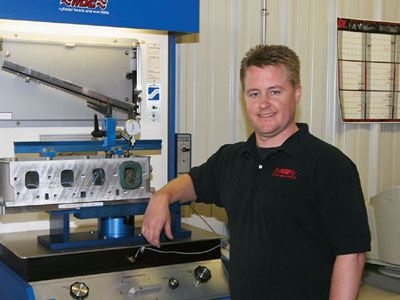
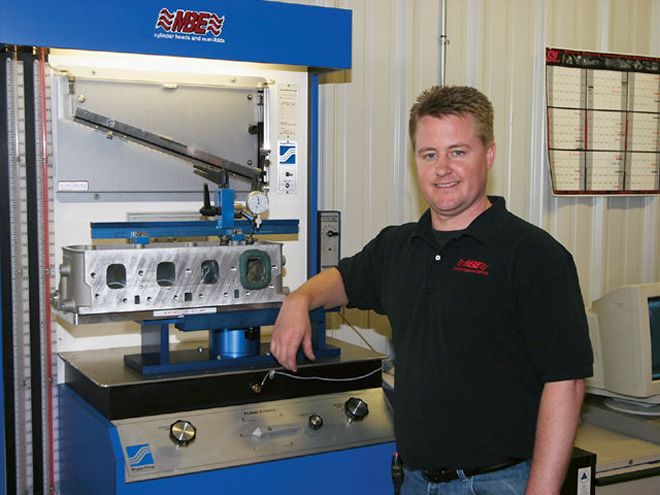 Matt Bieneman of MBE Cylinder Heads and Manifolds stands with his Dodge cylinder head that's being fine-tuned on the flow bench.
Matt Bieneman of MBE Cylinder Heads and Manifolds stands with his Dodge cylinder head that's being fine-tuned on the flow bench.
You might think that after all these years the pushrod V-8 has been in existence, cylinder head design would have been perfected. Think again. When it comes to cutting ports and combustion chambers for stock car racing, cylinder head specialists are still refining the art of power.
The reason cylinder head designs are still advancing is there are so many variables that must be optimized, and engine builders are still learning exactly how they all work together. Elements such as port volumes and shapes, combustion chamber shape, seat depth, and valve angle, just to name a few, involve the cylinder head. Add in the rest of the engine and you get thousands of decisions that must be made-and nearly every one affects the next decision down the line.
Next to the hand grinder, the greatest tool allowing advancements in cylinder head designs has easily been the computer-specifically CAD programs. Hooked to CNC milling machinery, computer technology has helped cylinder head specialists dramatically increase repeatability from one head to the next, which in turn has allowed them to consistently inch progress forward a bit at a time. Computer power also allows flow bench precision down to tenths of cfm in terms of airflow. There may be few big gains left in racing, but the small gains are still plentiful, thanks to these tools. One of the biggest is including the intake manifold when designing the intake port.
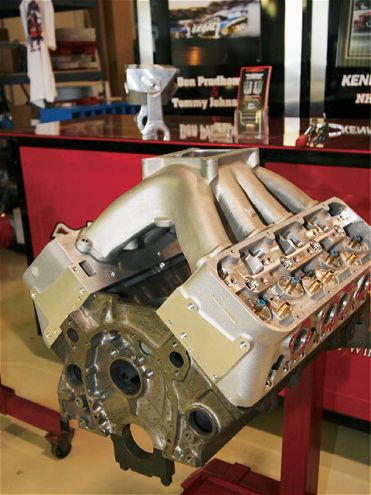
Matt Bieneman is a former cylinder head specialist with Joe Gibbs Racing as well as a few drag racing teams. Recently, he went on his own to form MBE Cylinder Heads and Manifolds and was willing to share a few of his philosophies for making power in CNC cylinder heads. Since starting MBE, Bieneman has outfitted intakes or manifolds for Joe Nemechek's Busch Series team (including his pole at Daytona in 2003), Travis Kvapil's Tri-Star championship in 2003, and Ray Evernham's Nextel Cup teams.
Interestingly, Bieneman says he pays more attention to port shape and volume than flow numbers when working with a new head. "We just use the flow bench to fine-tune our work," he says. "We don't even turn the flow bench on until we feel we've gotten all our areas right."
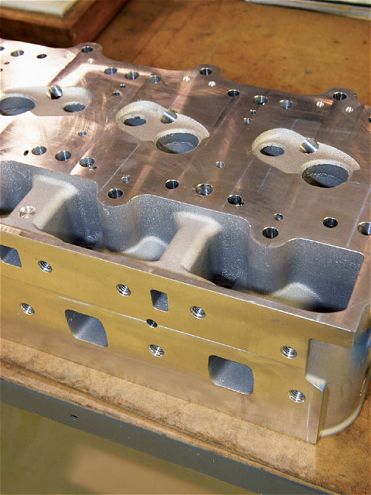 CNC head ports often work with specific head manufacturers (MBE, for example, is a Dart distributor) to receive raw castings. This gives them a head with plenty of material that needs to be cut away, but it also allows them plenty of material to work with.
CNC head ports often work with specific head manufacturers (MBE, for example, is a Dart distributor) to receive raw castings. This gives them a head with plenty of material that needs to be cut away, but it also allows them plenty of material to work with.
The areas he's talking about are the port dimensions, which are broken up into several areas from the port entrance all the way to the bottom of the combustion chamber. "When we start looking at a new cylinder head, the first thing we look at is where the seat depths need to be," he says. "You need to get the right seat depth in relation to the spark plug location. You want the plug about as deep as you can get it, but in stock car racing you can rarely move the plug location, so you have to work with the seat depth. Seat depth and location also have a bearing on where the port is and the angle of the port. What it does to the chamber volume isn't too important yet because we haven't decked the head. Once you feel you have all those relationships right, you can move on from there.
"Then we'll start grinding out a combustion chamber by hand. Once you sketch where the cylinder walls meet the deck of the head, you can decide where the exhaust needs to be. The exhaust is always close to the edge of the chamber because it isn't required to flow as well. The intake is farther from the cylinder wall because you have to minimize shrouding of the airflow as it moves into the chamber. Moving air will follow a surface, so you need to use the combustion chamber to guide the incoming air/fuel mixture into the chamber."
Bieneman also says he has moved away from heart-shaped combustion chambers (chambers with material between the intake and exhaust valves opposite the spark plug). He has found that, at least with his designs, they harm the efficiency of the combustion. Instead, a straight cut between the intake and exhaust valves opposite the spark plug usually results in knocking 111/42 degrees advance out of the assembled engine. The result is a more efficient engine with better power production.
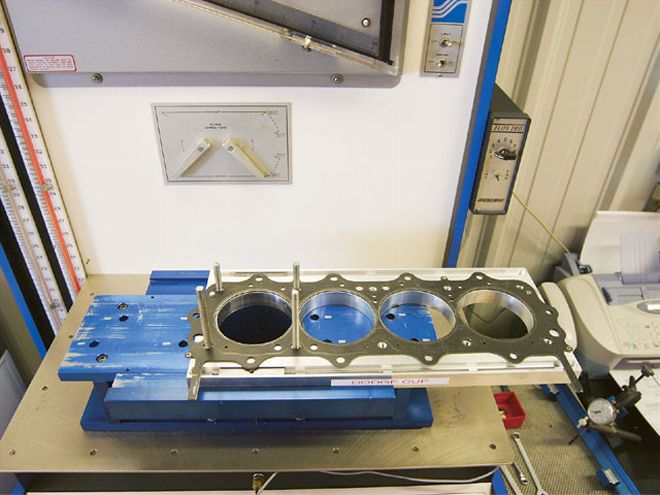 MBE never tests a cylinder head design bolted directly to the flow bench. Instead, it uses specially designed plates that mimic the deck of an engine block and the way in which the first inch of the cylinder wall affects valve shrouding. This also allows the traits of a specific head gasket to be worked into the picture, as well.
MBE never tests a cylinder head design bolted directly to the flow bench. Instead, it uses specially designed plates that mimic the deck of an engine block and the way in which the first inch of the cylinder wall affects valve shrouding. This also allows the traits of a specific head gasket to be worked into the picture, as well.
Flow: Intake versus Exhaust One of the most important relationships in a cylinder head is the amount an intake port is capable of flowing versus the exhaust port. According to many sources, the best ratio is an exhaust port that flows approximately 75 percent of what the intake is capable of flowing. Bieneman has seen the same results in his work and says this ratio holds true no matter what type of engine you are building. A good example is the big-block Chevy head program he has begun for DIRT Modifieds.
"We don't believe in putting a big exhaust valve in anything," he says. "In the big-block racing head, the casting was designed for a 1.88-inch exhaust valve, and we ended up putting a 1.8 valve in. We even had to change the seats to get it to accept a valve that small, but it just makes the headwork better. Even with the smaller valve, the port flows what the 1.88 valve did. That brings up the velocity and makes the head more efficient-not to mention what a smaller valve means in terms of valvetrain stability.
"Even if we have room to create a bigger exhaust port, we believe the relationship between the intake and exhaust is so important that we won't. If that relationship is off, you may not see it on the dyno, but you will see the difference on the track. A good 75-percent head seems to always accelerate better. We've all heard stories about engine builders that can build a race engine that looks great on the dyno but is a dog on the track, and I believe this has a lot to do with it."
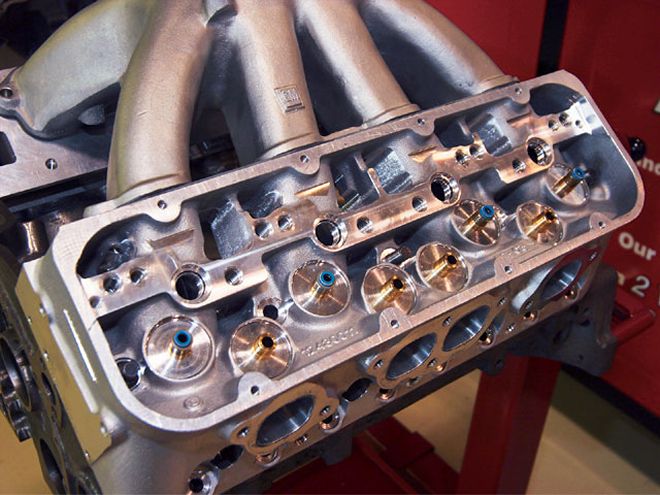 A good head designer will take the height of the spring pads into account. If the spring height stays the same, a tall pad means a longer valve stem must be used, increasing the weight that the springs must control at high rpm.
A good head designer will take the height of the spring pads into account. If the spring height stays the same, a tall pad means a longer valve stem must be used, increasing the weight that the springs must control at high rpm.
Valve Design
Once Bieneman settles on a design for the ports and combustion chamber, he turns his attention to the requirements that his design places on the valves. MBE has a working relationship with Stealth, which allows him to design titanium intake and exhaust valves exactly to his specifications. Using specialized software, Bieneman can design a valve and determine exactly how much it will weigh. If it is too much, he can tweak either the valve or head design until it meets his criteria. His reasoning for going to such great lengths is simple: Cylinder head design has a big impact on valvetrain stability.
When it comes to the cylinder head, many factors that affect the valvetrain are in the geometry it dictates. MBE typically designs heads to accept the biggest pushrods possible. The company works to drop the spring pads as close to the combustion chamber as possible. For a given spring height, a thick spring pad means a longer valve stem is required. Long valve stems mean unnecessary weight in the valvetrain, and we don't have to tell you what that means.
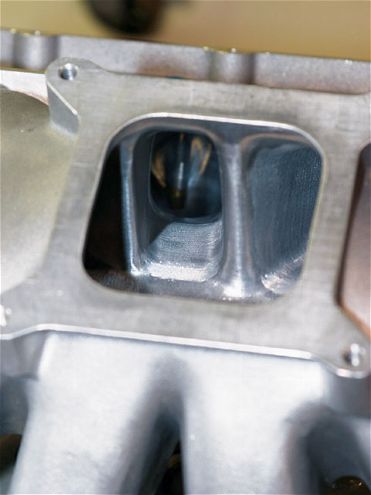 This shot shows the optimum relationship between the intake manifold and the cylinder head intake port. There are no obstructions, the angle of flow is continuous, and you can almost see the bottom of the intake valve. The result is fantastic flow and plenty of signal at the carburetor.
This shot shows the optimum relationship between the intake manifold and the cylinder head intake port. There are no obstructions, the angle of flow is continuous, and you can almost see the bottom of the intake valve. The result is fantastic flow and plenty of signal at the carburetor.
Include the Intake Manifold
Intake manifold matching has been going on for years. Typically, it means taking parts of either the intake runner exit or the cylinder intake entrance to make them match up without any ridges to impede airflow. Smart engine builders and cylinder head specialists have begun taking that a step further. An engine does not recognize where the intake runner ends and the cylinder port begins; it only recognizes if there is an obstruction that disrupts the flow of the incoming air/fuel charge or something that causes the fuel to drop out of suspension.
This can be caused not only by a ridge that results from incorrect alignment of the intake manifold runner and the cylinder head intake port, but also from a change in the direction of flow, which is much harder to correct. An engine is able to pull in the largest, most homogeneously mixed air/fuel charge when it can create a strong signal at the carburetor venturis. The best way to do this is to create a straight shot between the carburetor and the seat of the intake valve. This isn't always possible in a pushrod V-8, but generally speaking, the more you can do, the better.
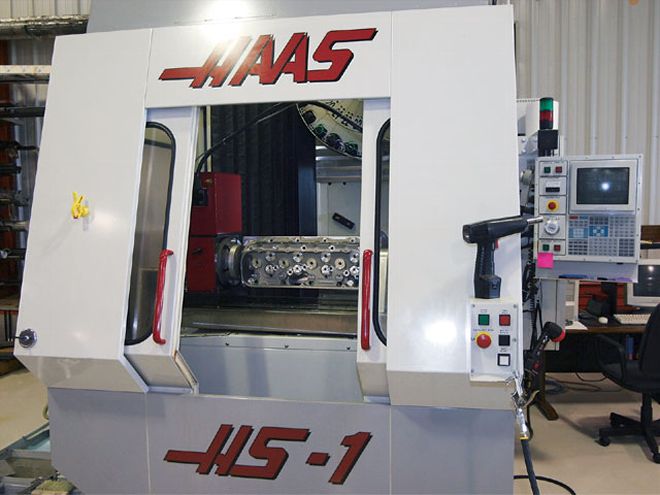 Most CNC heads are cut on five-axis machines like the one MBE uses. The results are the same run after run. This means no more worrying about getting a "bad" set of heads because your head porter wasn't on top of his game the day he cut your heads.
Most CNC heads are cut on five-axis machines like the one MBE uses. The results are the same run after run. This means no more worrying about getting a "bad" set of heads because your head porter wasn't on top of his game the day he cut your heads.
MBE began experimenting with fully CNC'd intake manifolds while looking at ways to improve its Nextel Cup heads. "In Nextel Cup, they are now pushing 9,700 to 9,800 rpm, and that places a big stress on the head to flow enough air to properly fill the combustion chamber in a very small amount of time," Bieneman says. "There is a reason well-designed cylinder head ports are the size they are. Low-rpm engines need smaller ports to make good low-end torque. High-rpm engines like we see in Nextel Cup racing need big intake ports to allow plenty of air and fuel into the combustion chamber at the upper-rpm range.
"That's when we noticed that it was the intake manifold that was becoming the limiting factor. We reached a point where the intake runners were choking off what the cylinder head was receiving. So we began considering the intake runner as a continuation of the intake port. We began working the runner and port together, creating volumes that worked as well as possible. We looked for an angle of flow from the carburetor to the intake valve that was as direct as we could get. The results were just fantastic; not only did we improve power, but we moved peak power 400 rpm higher. That's almost unheard of."
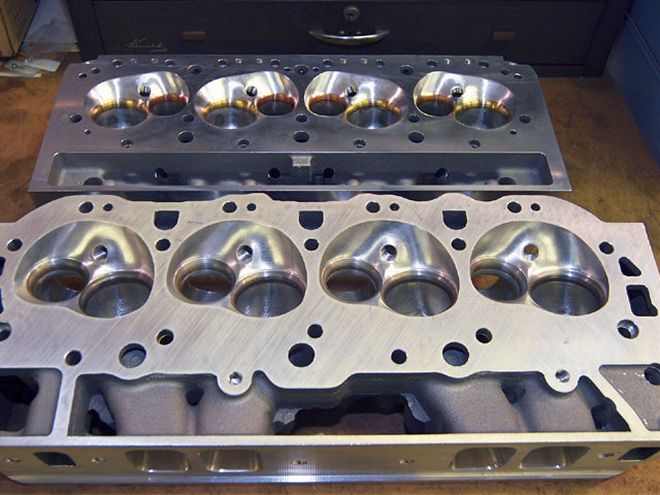 Not every trick works with every cylinder head. In the back is a Chevrolet SB2 head. In front of it is a big-block head for DIRT Modified racing. For small-block heads, a laid-back wall beginning right at the valve seat creates the best results, but that wouldn't work for big-blocks. There is just too much wall area, so the best design is to go ahead and cut the material away from the seats. This creates a bigger chamber and a more vertical combustion chamber wall, but the improvement in flow into the combustion chamber is worth it.
Not every trick works with every cylinder head. In the back is a Chevrolet SB2 head. In front of it is a big-block head for DIRT Modified racing. For small-block heads, a laid-back wall beginning right at the valve seat creates the best results, but that wouldn't work for big-blocks. There is just too much wall area, so the best design is to go ahead and cut the material away from the seats. This creates a bigger chamber and a more vertical combustion chamber wall, but the improvement in flow into the combustion chamber is worth it.
Once MBE realized the potential that was available from machining cylinder heads and intake manifolds as a package, the company began working to translate what it has learned from its Nextel Cup pieces to how it can help engine packages for traditionally "lower level" racing. Some of the head/manifold combinations required extensive work to optimize, but Bieneman says the results are worth it. For example, in his big-block cylinder head program, Bieneman moved two of the intake port entrances on each head over 0.2 inch. That makes for a lot of aluminum to be cut away, but Bieneman reports that the resulting improvement in the ports produces a significant improvement in both torque and horsepower. Not too bad when engine builders have to fight for a five-horsepower advantage wherever they can find it.
A premium set of CNC-ported cylinder heads is of little use if your out-of-the-box intake manifold is harming the flow of the air/fuel mixture into the combustion chambers.